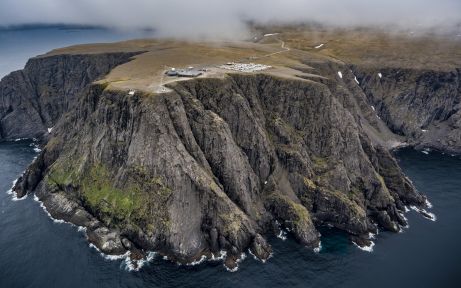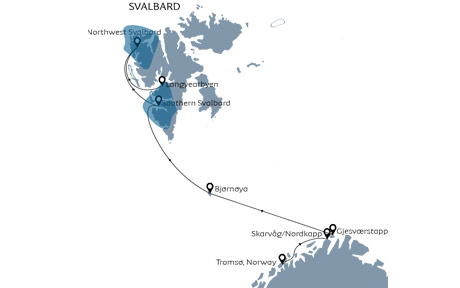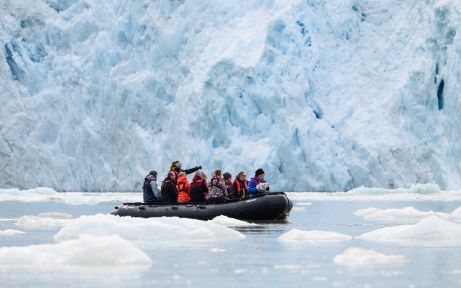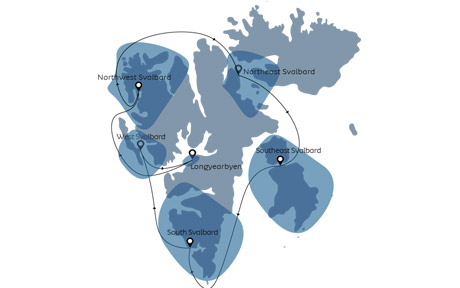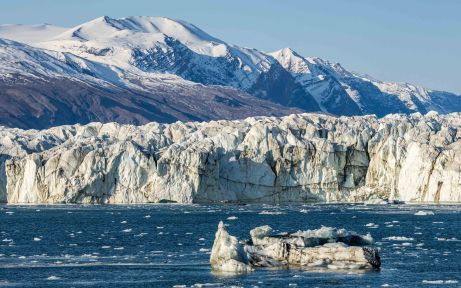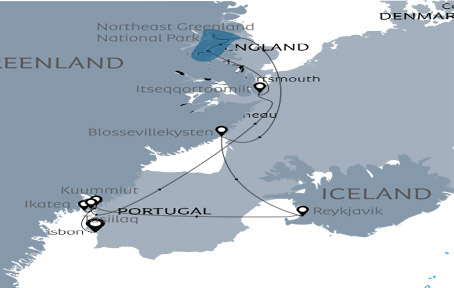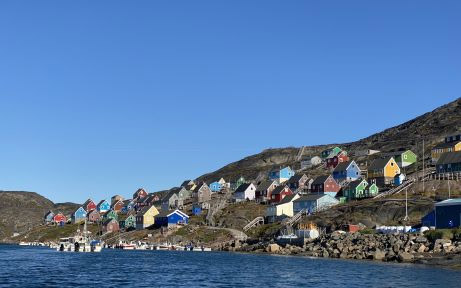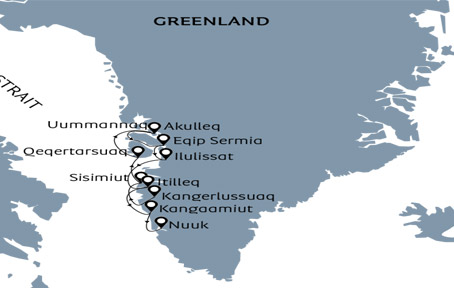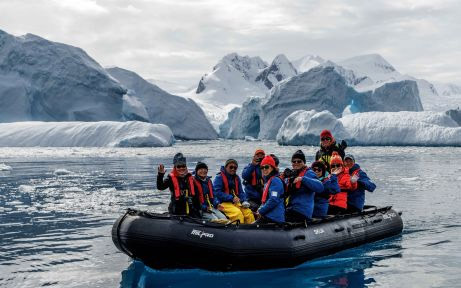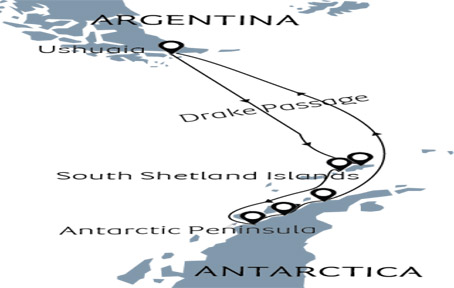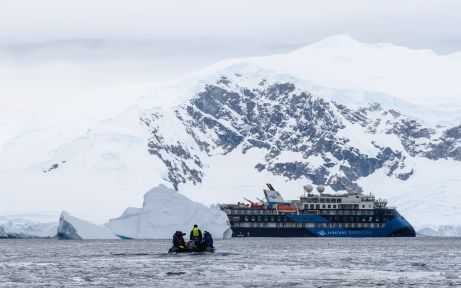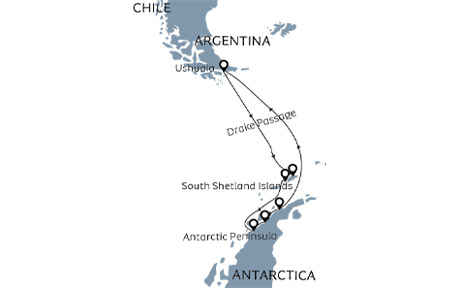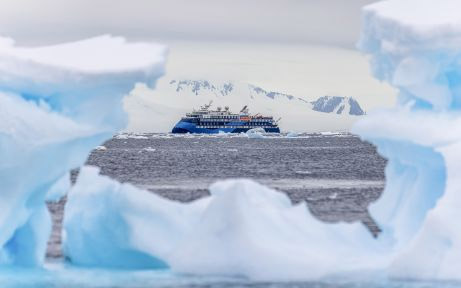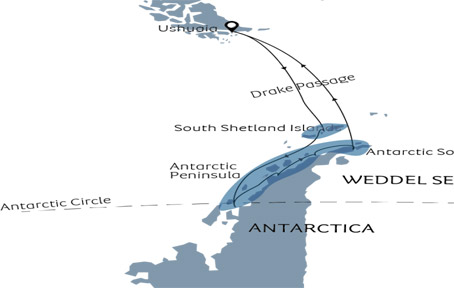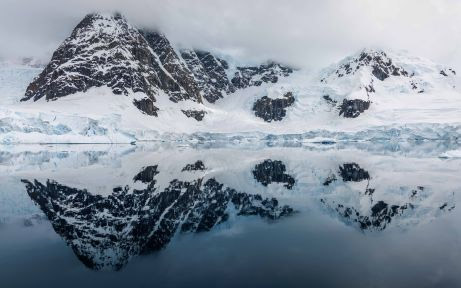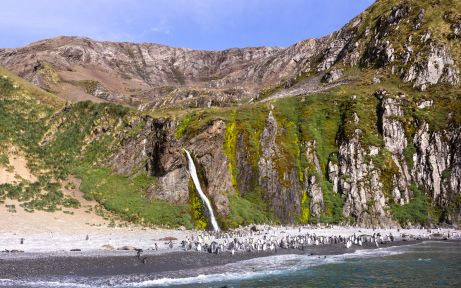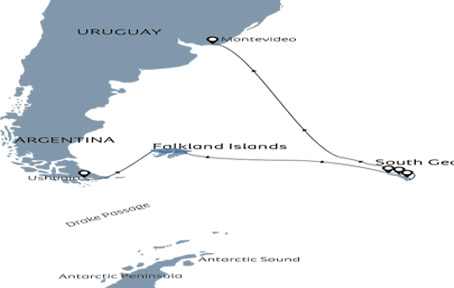
Expert guidance for your cruise vacation!
Let us connect you with our cruise expert to help you to plan the best vacation at the lowest possible price. For fastest service, call us at +91 9920688575
Arctic Odyssey - from Norway to Svalbard
Cruise Line: Albatros Cruises
Ship: Ocean Albatros
Sailing Dates: May 30 2025
Port: Tromso, Norway to Longyearbyen, Svalbard
Arctic Odyssey - from Norway to Svalbard
Day 1
Tromso, Norway - Embarkation
Arrive in Tromso, the majestic 'Capital of the Arctic'. Situated deep in the maze of fjords for which Norway is famous, Tromso sits on an island surrounded by steep mountains and plunging seas.
Known worldwide as Norway's Arctic capital, Tromso is the largest city in the European Arctic with around 80,000 residents, and is the hub for transport, industry and tourism throughout the region. Visitors from all ober the world come to experience this vibrant city, as well as explore the stunning nature which surrounds it, or to simply bask in the midnight summer sun.
Ocean Albatros awaits in the calm waters of the city harbour, ready to take our guests on a spectacular journey, leaving Europe behind and heading into the wild north beyond. After the mandatory safety drill, relax on the outer decks sipping a carefully crafted cocktail as Ocean Albatros sets sail through the fjords of northern Norway.
Day 2
Gjesaerstappan, Skarsvag and the North Cape
In the early morning of the first full day of our expedition, we will arrive at Gjesaerstappan, a maze of rugged islands and skerries off the coast of the small village of Gjesaer. These islands were designated a nature reserve in 1983, and exploring on the nearby waters cleary shows why! These islands hold an incredible amount of life, with vast colonies of kittiwakes, guillemots, razorbills, puffins and gannets all nesting in the area - one of Norway's greatest natural wonders!
Ocean Albatros will reposition over lunchtime to the tiny village of Skarsvag. Skarsvag holds the distinction of being the most northerly fishing village in the world, and many residents work harvesting the rich chilly waters at the top of Scandinavia. From Skarsvag, we will join an excursion to Nordkapp, the monument which marks the northernmost tip of mainland Norway and the European continent. This famed landmark beckons us to the next part of our journey, as we leave civilisation behind in the evening, and strike out towards the wild Arctic islands of Svalbard.
DAY 3
Bjornoya/Bear Island
Situated in the middle of the Barents Sea between northern Norway and southern Svalbard lies Bjonoya, known in English as Bear Island. This rugged island marks the start of the High Arctic, as the peaks of the island loom on the horizon.
Small, isolated and rarely visited, Bear Island was once heavily exploited by whalers and sealers, who flocked to the island from across Europe to harvest oil-bearing marine mammals. Thankfully, the island and surrounding waters are now protected as a nature reserve, and the island is returning to natural abundance. Despite the name, polar bears are almost unknown here, but whales and seals are common in these rich waters, and the steep cliffs of the isalnd are home to literally millions of seabirds. Guillemots, razorbills, puffins and gannets all crowd for space on tiny rock ledges, while hungry gulls and skuas cruise overhead in a never-ending search for prey.
If conditions permit, we will aim to offer a Zodiac cruise with our expert expedition team to experience the incredible wildife of this remote island - a true bucket-list experience!
DAY 4
Southwest Svalbard
The southwest coast of Svalbard is washed by warmer water coming up through the Atlantic, so winter ice generally retreats first from this reagion. This allows us to enter the southern fjords of the area, even at the start of the summer - easily some of the most spectacular regions of this stunning archipelago. Throughout this maze of fjords and islands, birds cluster together on high cliffs and reindeer graze on the fertile slopes below, while icebergs drift by from the various large glaciers in the area. Tiny calico snow buntings flit between crags, while perfectly camouflaged purple sandpipers scamper along the shore. Look higher up on the vegetated slopes, and there - greyish white 'boulders' move and resolve themselves into sheep-sized reindeer: the unique subspecies native to Svalbard. A flash of bluish-black, and the screeches of nearby birds herald the arrival of the Arctic fox, the only native land predator on Svalbard (the polar bear being classified as a marine mammal).
The mountaintops are most often covered by dense clouds and the East-Spitsbergen current often leads pack ice into the mouths of the fjords. With a huge variety of landing sites to explore, this region is without doubt one of the most exciting and diverse regions of Svallbard! Options to explore in the area include the huge bird cliffs of Alkhjornet and VÃ¥rsolbukta, and the historical sites of Calypsobyen and Bambsebu, where prospectors, trappers and a range of other adventurers attempted to make their fortunes.
DAY 5-7
Northwest Svalbard
One of the largest protected wilderness areas in Europe, North West Svalbard was declared a national park in 1973. The area is famed for its history, which documents some of the earliest human arrivals on Svalbard. While Norse explorers may have sighted these icy shores during the Viking Age, the first definite arrival was the expedition of William Barents, the legendary Dutch explorer for whom the Barents Sea is named. While now protected from human distruption, when Barents arrived in 1596, he noted the vast numbers of whales and seals which were soon prey to English and Dutch whalers, who arrived within a decade of Barents to pillage the area's wildlife. The area occupies the triple point between land, sea and ice, and as such was the perfect location from which to harvest the gentle giants of the oceans. Sites used to dismember whale carcasses and render them for their precious oil include the Dutch settlement of Smeerenburg, where the remains of 16th Century blubber ovens and building foundations can still be seen. Other sites such as nearby Ytre Norskoya record the darker side of this industrialised slaughter, where hundreds of young men who hoped to make their fortunes are buried thousands of miles from home.
Today, all that remains from this period of history are bones and the scant remnants of human habitation. Slowly reclaimed by creeping Arctic nature, the region is now a nature lovers paradise. Tiny Arctic poppies and purple saxifrage defy the brutal conditions to flower in the brief summer, while geese, eider ducks and other seabirds return to the island to raise their young. Walrus can be found hauled out on beaches, and we must always be on careful lookout for wandering polar bears in this now again wild region.
A haven of wildlife, fascinating history and jaw-dropping scenery, northwest Svalbard is surely one of the most spectacular areas of the Arctic, if not the world!
DAY 8
Longyearbyen, Svalbard - Disembarkation
On the final morning of our expedition, we arrive in Longyearbyen, Svalbard - the world's northernmost... everything! This remarkable little city is not only the northernmost town in the world (if one excludes the tiny research community of Ny-Alesund, slightly further north on Svalbard), but also hosts the world's northernmost civilian airport, schools, bank and supermarket.
The town's rugged frontier edge belies a core of warm Nordic hospitality and coziness, with comfy cafes, excellent restaurants and boutique shops all within walking distance. Even this small town will feel like a metropolis after days of isolation in the wilderness of the Arctic!
After enjoying exploring Longyearbyen and a fond farewell to the crew and fellow guests of Ocean Albatros, guest will be transported to Svalbard Airport to flyy back to the Norwegian mainland- with memories to last a lifetime.
Svalbard Circumnavigation
Cruise Line: Albatros Cruises
Ship: Ocean Albatros
Sailing Dates: June 18 2025 | Jun 28 2026 | Jul 07 2026
Port: Longyearbyen, Spitsbergen to Longyearbyen, Spitzbergen
Svalbard Circumnavigation
Day 1
Longyearbyen, Spitsbergen. Embarkation
Board your flight in Norway and arrive in Longyearbyen, Svalbard - the world's northernmost... everything! This remarkable little city is not only the northernmost town in the world (if one excludes the tiny research community of Ny-Alesund, slightly further north on Svalbard), but also hosts the world's northernmost civilian airport, schools, bank and supermarket. The town's rugged frontier edge belies a core of warm Nordic hospitality and coziness - hyggligt, as we say in Denmark!
Immediately after landing in Longyearbyen, you find yourself in a different world. The chilly Arctic breeze can be felt as soon as you step onto the tarmac, and the famous signpost outside the terminal reminds visitors how far north they really are; as well as to keep watch for bears! The snow-capped mountain Hjorthfjellet looms over the airport on the far side of Adventfjorden, and off in the distance can be seen the saw-toothed peaks and languid glaciers of northern Spitzbergen.
After arrival, you will board the awaiting Ocean Albatros. After our mandatory safety briefing and lifeboat drill, head onto the outer decks to enjoy a glass of champagne while watching your expedition vessel leave civilisation behind... And set a course for adventure!
DAY 2
Kongsfjorden region, northwest Spitzbergen
During the ânightâ (what is night, when the sun never sets?), Ocean Albatros will have repositioned past the saw-toothed mountains of Prins Karls Forland and arrived in magnificent Kongsfjord. Surrounded by craggy mountains, bounded by the magnificent Kongsbreen and Kongvegen Glaciers, and crowned by the Three Crowns (a set of pyramidal mountains said to represent the monarchies of Norway, Sweden and Denmark), this is surely one of the most beautiful and tranquil corners anywhere in the world.
Our first landing will be at the small settlement of Ny Alesund. Situated further north than Longyearbyen, Ny-Alesund is Earth's northernmost settlement, if a group of scientific stations, a post office and a single shop open for a few hours can be described as such... You will have to judge for yourself!
These islands' geographical location has made them the staging post for exploratory and scientific expeditions for centuries - a proud legacy which continues to this day. The setting is spectacular, and the scientific projects are as fascinating as the history of the town, which has hosted the Nobile, the Norge and the Fram, Amundsen, Nansen and Nordenskiöld, all legends of polar exploration who passed this lonely outpost seeking to push the boundaries of humanity. The remnants of these expeditions (such as the mooring mast of the Norge) can still be seen today.
DAY 3
Northwest Spitzbergen
One of the largest protected wilderness areas in Europe, North West Svalbard was declared a national park in 1973. The area is famed for its history, which documents some of the earliest human arrivals on Svalbard. While Norse explorers may have sighted these icy shores during the Viking Age, the first definite arrival was the expedition of William Barents, the legendary Dutch explorer for whom the Barents Sea is named. While now protected from human distruption, when Barents arrived in 1596, he noted the vast numbers of whales and seals which were soon prey to English and Dutch whalers, who arrived within a decade of Barents to pillage the area's wildlife. The area occupies the triple point between land, sea and ice, and as such was the perfect location from which to harvest the gentle giants of the oceans. Sites used to dismember whale carcasses and render them for their precious oil include the Dutch settlement of Smeerenburg, where the remains of 16th Century blubber ovens and building foundations can still be seen. Other sites such as nearby Ytre Norskøya record the darker side of this industrialised slaughter, where hundreds of young men who hoped to make their fortunes are buried thousands of miles from home.
Today, all that remains from this period of history are bones and the scant remnants of human habitation. Slowly reclaimed by creeping Arctic nature, the region is now a nature lovers paradise. Tiny Arctic poppies and purple saxifrage defy the brutal conditions to flower in the brief summer, while geese, eider ducks and other seabirds return to the island to raise their young. Walrus can be found hauled out on beaches, and we must always be on careful lookout for wandering polar bears in this now again wild region.
DAY 4
Into the ice
An icy breeze touches your exposed cheeks. The scent of snow and sea fills your nostrils. Sunlight reflects off the floating ice, illuminating the clouds overhead. Enter an environment like no other, the vast shape-shifting realm of floating ice which crowns our planet. The vast ever-changing ice pack to the north of Svalbard stretches from this already isolated archipelago to the North Pole, and onwards across the Arctic Ocean towards the northern shores of Chukotka and Alaska.
The Arctic ice pack is one of Earth's largest habitats, although unlike most it varies hugely year on year, expanding in winter and retreating in summer. The location of the sea ice around Svalbard can also vary wildly - however, your Expedition Leader will work hard to maximise our chances of finding and exploring this impossibly remote environment. At first glance, this stark white wilderness seems barren, empty and lifeless. This icy wilderness holds on to its mysteries, and of course wildlife sightings are at the whims of Mother Nature. With a little perseverance however, the ice reveals its secrets.
As Ocean Albatros pushes through the narrow channels in the ice, tiny cod-like fish can be seen silhouetted against the ice in the clear water. Kittiwakes and Gloucous Gulls follow the vessel as it disturbs the water. Further out on the ice, black dots appear; moving closer, they resolve into seals, basking on the ice. A plume of water reflects the sunshine - a pod of belugas perhaps, or maybe even the vast gentle bowhead whale crushing the ice from below as its massive body surfaces. There, beyond the banks of rucked ice - a yellowish dot pads along the ice, the head swinging from side to side: the King of the Arctic continues his never-ending quest for prey. This is the kingdom of the polar bear, the vast icy wastes at the top of the world.
At the end of the day, we will start cruising towards the Hinlopen Strait that divides Spitsbergen and Nordaustlandet.
DAY 5
Northwest Svalbard
From the icy wilderness of the pack ice, we will head back towards land, cruising into the Hinlopen Strait. If the weather is on âour sideâ we may have a good view of the steep cliffs of Alkefjellet. The area is home to a dense congregation of Brünnichs guillemots - one of the largest colonies in the world. There are so many birds that hardly an inch is free! Nesting Brünnich's guillemots and other auks crowd the cliffs, while predatory skuas and gulls cruise the skies above, constantly on the lookout for their next meal. During the raucous summer the breeding pairs offer a wild view of frantic activity, both along the cliffs and in the sea in front - one of nature's most spectacular sights!
More wildlife awaits us as we land on the polar desert landscapes of Nordaustlandet. Although the polar desert landscapes of this region appear stark and barren, they are wildly beautiful - unearthly plantless landscapes illuminated by the weak Arctic sunlight. However, it is in the marine environment where Svalbard's biodiversity is richest. Walrus haul their vast bodies onto flat beaches to rest, where they snuggle together for warmth and protection. Belugas frolic in large pods in the waters off the coast, harvesting fish and crustaceans from the seabed, and further offshore the vast gentle baleen whales can sometimes be seen feasting upon copepods and small fish.
DAY 6
East Svalbard
As we continue to venture around these remarkable islands, we arrive in Southeast Svalbard - a region where the cold easterly polar waters collide with the last tepid gasp of the Gulf Stream. If the ice is passable, we can make it through the southern edge of the Hinlopen Strait and cruise through Freemansundet, which separates Barentsoya and Edgeoya. We enjoy the views of the massive Kapp Lee as we exit the Strait.
We will aim to land on Edgeoya, Svalbard's third largest island. Vast piles of snow-bleached bones on the island's beaches bear witness to the systematic and industrial-scale slaughter of walrus and beluga in their thousands. The earliest humans on the islands (mainly English and Dutch whalers and Russian Pomor trappers) had little regard for conservation, seeking only profit, a situation which continued well into the 19th century. Thankfully all wildlife on Svalbard is now protected by law, and vast tracts of the archipelago are designated as nature reserves and National Parks - some of the largest and richest in the world!
Further east on Edgeoya, sites include the walrus colonies of Andreetangen and Kapp Lee, and the spectacular raised shorelines and bird colonies of Sundneset. From these remote shores, we will cruise around Sorkapp and back towards Spitzbergen, the largest island of Svalbard.
DAY 7-8
South Svalbard
Having passed the southern tip of Spitsbergen we arrive back into the greener warmer regions of this Arctic wilderness. The southwest coast of Svalbard is washed by warmer water coming up through the Atlantic, so winter ice generally retreats first from this reagion. This allows us to enter the southern fjords of Bellsund and Hornsund - easily some of the most spectacular regions of this stunning archipelago. Throughout this maze of fjords and islands, birds cluster together on high cliffs and reindeer graze on the fertile slopes below, while icebergs drift by from the various large glaciers in the area. Tiny calico snow buntings flit between crags, while perfectly camouflaged purple sandpipers scamper along the shore. Look higher up on the vegetated slopes, and there - greyish white 'boulders' move and resolve themselves into sheep-sized reindeer: the unique subspecies native to Svalbard. A flash of bluish-black, and the screeches of nearby birds herald the arrival of the Arctic fox, the only native land predator on Svalbard (the polar bear being classified as a marine mammal).
The mountaintops are most often covered by dense clouds and the East-Spitsbergen current often leads pack ice into the mouths of the fjords. With a huge variety of landing sites to explore, this region is without doubt one of the most exciting and diverse regions of Svallbard! Options to explore in the area include the huge bird cliffs of Alkhjornet and Varsolbukta, and the historical sites of Calypsobyen and Bambsebu, where prospectors, trappers and a range of other adventurers attempted to make their fortunes.
DAY 9
West/Central Spitzbergen
During the night we will enter Forlandssundet, the strait which separates Prince Karls Forland from Spitsbergen. Our destinations may include Poolepynten (Poole Point), a small headland named after the British whaler Jonas Poole. Today the area is inhabited by herds of walruses who can be seen (and smelled!) from a distance. The large mammals flaunt their tusks and whiskers, as well as their considerable bulk. The remote beaches, rugged mountains and tundra plains of the region positively beg to be explored!
From Forlandsundet, we will return southwards during the afternoon towards the town of Longyearbyen, all the while on the lookout for wildlife and spectacular views as we return to civilisation.
DAY 10
Longyearbyen, Spitzbergen. Disembarkation
During the evening, the Ocean Albatros will reposition to return to the port of Longyearbyen. Even this small town will feel like a metropolis after days of isolation in the wilderness of the Arctic!
After enjoying exploring Longyearbyen and a fond farewell to the crew and fellow guests of Ocean Albatros, return to Svalbard Airport and join your flight back to the Norwegian mainland- with memories to last a lifetime.
Complete East Greenland
Cruise Line: Albatros Cruises
Ship: Ocean Albatros
Sailing Dates: Sep 17 2025
Port: Reykjavik, Iceland to Reykjavik, Iceland
Complete East Greenland
Day 1
Reykjavik, Iceland
The rock-like columns of HallgrÃmskirkja Church loom over the city of ReykjavÃk, a hip Scandi capital which needs little introduction. With new Nordic cuisine, excellent shopping, fantastic excursions and an easy relaxed vibe, ReykjavÃk is one of Scandinavia's most welcoming and exciting cities.
In the afternoon, we await to welcome our guests onboard Ocean Albatros. After our mandatory safety drill, enjoy dinner and a glass of champagne as we set sail a course for adventure as we set out across the Denmark Strait, bound for Greenland.
Day 2
At sea, Crossing the Denmark Strait
The Denmark Strait is the narrow section of the North Atlantic separating Iceland from Greenland. This body of water is among the most productive in the world, where the cold polar East Greenland Current collides with the warm northbound Gulf Stream. These nutrient-rich waters support vast stocks of fish, and the humans, seals, whales and seabirds which rely on them.
Days at sea are never dull. We will arrange a variety of activities onboard for our guests to enjoy to engage the mind, body and soul. Join your knowledgeable Expedition Team lecturers in the Theatre to hear specially-crafted lectures on Greenlandic history, wildlife, geology, culture and more, unwind with a massage in the Albatros Polar Spa, or simply watch the seabirds gliding along the ship from our hot tubs as the Ocean Albatros flies across the Denmark Strait.
Day 3
Kuummiut and Ikateq
We will spend the morning in the small village of Kuummiut, which sits in breathtaking surroundings in the calm reaches of Ammassalik Fjord. Kuummiut - meaning 'People who Live by the River' - is one of the larger villages in the area, and one of the most prosperous. Sitting upon some of East Greenland's richest fishing grounds, Kuummiut holds the only fish factory in the region, and fishermen from miles around come through Ammassalik Fjord (which is wide enough to stay mostly ice-free year-round) to sell their catch here.
Kuummiut is an ideal place to experience life in an East Greenlandic settlement. Where other towns have traffic, Kuummiut has the yowling of sled dogs and the sigh of the wind through the grass. No roads lead in or out of this isolated village, and the sea is the highway for local transport - although motorboats have replaced the skin boats which brought people to these shores long ago. It is a perfect place to simply sit, watch the icebergs pass, and perhaps see the whales which often frolic in the calm waters offshore.
In the afternoon, we will sail slightly eastward from Kuummiut to Ikateq, a spectacular fjord with a fascinating history. During the darkest days of the Second World War, American forces established an airbase here (one of the network of air bases which includes Kangerlussuaq on the west coast) to serve as a stepping stone for aircraft transiting between Europe and North America. The rugged landscape of East Greenland meant the approach into the airport was hazardous, with frequent fog masking the treacherous mountains. Huge recources were invested into Ikateq Airbase (also known as Bluie 2 East), with a 5,000ft runway, hangar, barracks and port constructed. A fleet of military vehicles and thousands of barrels of fuel were also brought to this remote region. With Germany defeated, improvements to intercontinental aircraft, and increasing tensions with the Soviet Union, the United States Military abandoned the base in 1947, leaving almost everything behind.
The air base has been a bone of contention between Nuuk, Copenhagen and Washington for many years. Many in the Greenlandic government wanted the site cleaned up and the ruins removed; an expensive and logistically challenging task. Eventually, the Danish Government agreed to remove hazardous waste from the site (mainly decaying fuel drums), leaving the rest of the equipment in place as an important part of regional history. Over 75 years later however, almost everything remains as it was on the day the Americans left. Ikateq is a truly unique place, a time warp to the Second World War: eerie, fascinating and surrounded by staggering natural beauty.
Day 4
Tasiilaq
In the morning we arrive in Tasiilaq, the largest settlement in East Greenland. Unlike the west coast, which has had uninterrupted contact with Europe since the 1700s, the coast of East Greenland remained more or less uncontacted until around 1894, when a Danish trading post was established at Tasiilaq. The vast distances involved in Arctic travel meant that the people of East Greenland (Tunumiit) were isolated from their cousins to the west, and the language, traditions and culture of East Greenland therefore differ significantly to those in other parts of the country.
Ancient traditions are strong here. This region of Greenland was the home of the last Angakkuit (Shamans) of Greenland, and is the home of the tupilak - a monster fashioned from animal (and sometimes human) body parts and animated by the power of an Angakkuq to wreak havoc on enemies. Creating such a monster was dangerous, as it could be turned back by a more powerful magic user to attack its creator. The first Europeans were curious as to what these dark beasts looked like, and locals carved facsimiles in bone or horn, beginning one of Greenland's finest artistic traditions. The tupilaat made by artisans in Tasiilaq are considered among the best in the country.
Tasiilaq sits in a perfect natural harbour on Ammassalik Island (meaning 'the Place of Many Capelin'). While superficially similar to towns on the West Coast, visitors will quickly notice differences; the landscape here is much more rugged, the people fewer, and the sled dogs much more numerous. Tasiilaq offers excellent opportunities to explore, with excellent hiking routes such as the Flower Valley easily accessible from town. For those wishing to delve into Tunumiit culture, visit the museum, located in the city's old church, hear the city's exquisite choir perform in the modern church, or watch a drum dancer in traditional East Greenlandic costume perform a millennia-old spiritual tradition. For those wishing to indulge in some retail therapy, visit the Stunk Artist's Workshop, where skilled craftsmen create beautiful pieces from natural local materials.
Day 5
At sea, en route to Ittoqqortoormiit
Sailing along the coastline of this vast island (where reaching the next-closest town takes two nights and a day of sailing), it can be difficult to comprehend the scale of this huge country.
Measuring roughly four times the size of France, Greenland dominates the Atlantic portion of the Arctic, covering latitudes from 59-83°N, and 11-74°W. Around 80% of Greenland is covered by the Greenland Ice Sheet (known as Sermersuaq or 'The Great Ice' in Greenlandic), the largest body of ice on earth outside Antarctica. The Greenland Ice Sheet is so vast that it governs the weather patterns of the region, with summer meltwater and winter ice largely driving ocean currents in this part of the North Atlantic.
Despite the lack of towns, the stretch of coastline between the Ammassalik and Scorsesbysund region is of vital importance to the residents of the area. During the summer, locals hunt whales, seals and other game by boat along the coast of this vast wilderness, as their ancestors have done since time immemorial. Some skilled hunters still choose to use kayaks to sneak up on skittish prey like narwhals - continuing a millennia-old hunting tradition. While some choose to use snowmobiles in winter to traverse the sea ice which hugs the coast, most hunters choose to use dogsleds, which are more reliable, rugged, and do not rely on fuel. In this challenging country, ancestral traditions are still superior to the trappings of modern life.
Day 6
Ittoqqortoormiit
Entering Scoresbysund, Earth's largest and longest fjord system, one could be forgiven for not realising this huge 35km inlet is a fjord at all! Scoresbysund is named for English whaler and explorer William Scoresby, one of the first Europeans to map this region; the local name for this vast fjord system, Kangertittivaq, is a typical Greenlandic understatement, roughly meaning 'The Rather Large Fjord'.
The only settlement in this region is Ittoqqortoormiit (meaning 'the People who Live in Big Houses), which surely ranks among the most remote communities on Earth. As the name suggests, the town is relatively new, having been established by Danish authorities in 1925. Colonists were relocated from the Ammassalik region further south in response to what were seen as poor living conditions in the area, as well to establish Danish sovereignty in the region during a territorial dispute with Norway. While the establishment of the town was challenging, the settlers soon realised the region was hugely rich in game, with excellent hunting and trapping opportunities. This tradition continues to this day - the majority of residents continue to live a subsistence hunting lifestyle, essential in a town where supply ships arrive only once or twice each summer. The only access to the outside world is via the heliport to the nearby airport, from where small aircraft depart for Iceland.
Ittoqqortoormiit is a town with a strong sense of community and traditional culture, where foreigners are welcomed warmly. The town hosts an excellent museum, a beautiful traditional Greenlandic church, and locals often welcome visitors to their community wearing colourful traditional costumes. The town represents a wonderful introduction to the culture and lifestyle of Northeast Greenland, in one of the most spectacular natural locations anywhere in the world.
Day 7-9
Northeast Greenland National Park
During the night we cruise past the rugged peaks of the Liverpool Land peninsula and reach the mouth of King Oscar Fjord. We are now in the vast Northeast Greenland National Park; measuring almost a million square kilometers (almost twice the size of France), this is the largest National Park and the largest area of protected land on Earth and includes the northernmost land on the planet.
There are no permanent settlements in the area, but up to the middle of the 19th Century various nomadic Inuit hunters lived in this spectacular region, harvesting the natural riches of the area.
The program for our days in the National Park depends on wind, sea, weather and ice conditions. In such a remote region so far north, Mother Nature dictates all human activity. Our exact route and activities will be determined by the Captain and the Expedition Leader jointly and are typically announced the night before.
Some of the interesting landings we may visit include the 1300-meter-high rock wall Bastionen on the coast of Ella Island. Further north we may pass pass the small Maria Island, where the Germans had a camp during World War II. The Germans' attempt to gain a foothold in Greenland during World War II is a fascinating story in itself. Past Ruth Island, we hope to make a landing on Ymer Island at Blomsterbugten, a small oasis in the national park. From the tiny hunting lodge Varghytten we can enjoy the formidable view of the characteristic, flat mountain Teufelsschloss, where the multicoloured rock layers testify to the area's exciting geological development. From here, we may aim to sail by the mighty iceberg-producing Waltershausen Glacier before entering beautiful Moskusokse Fjord. On our way back towards open sea we might aim for landings on Jameson Land, which is a breeding ground for polar bears.
Wherever we go in this vast wilderness, our guests can be sure of encountering excitement, adventure, and mind-boggling natural beauty. Our experienced Expedition Team will be on hand to provide guests with as much knowledge of the region as possible; either in hand-crafted lectures, evening recaps, onshore, or over a cup of coffee on deck. Throughout our time in the National Park, our skilled Expedition Team members will be constant lookout for the charismatic wildlife of the region - keep your binoculars handy!
Day 10
Blosseville Coast
Possibly the most dramatic coast outside of Antarctica, the Blosseville is guarded by Greenlandâs highest mountains and steepest fjords â and a belt of pack ice which was once able to ward off explorers, sometimes for years at a time!
The Blosseville Coast is named for French Explorer Jules de Blosseville, the first European to sight this formidable coastline. While attempting to survey the coast in 1833 onboard the vessel La Lilloise, the vessel and all onboard were lost without a trace. Subsequent expeditions failed to find any trace of the vessel, and its fate remains a mystery to this day.
The recent decades have also had warmer summers and reduced sea ice cover, which enables purpose-built ice-strengthened vessels such as the Ocean Albatros to venture along the coast, on lookout for polar wildlife, abandoned Inuit settlements and otherworldly landscapes.
Day 11
At sea, en route to Reykjavik, Iceland
During our time at sea approaching Reykjavik, a variety of activities will be arranged on board to provide our guests with the chance to reflect on their voyage. Relax with an expertly crafted cocktail in the Nordic Bar in the company of new friends, soak up the knowledge and passion of our Expedition Team during lectures, or simply enjoy the flight of the fulmars which accompany us towards Iceland.
During your last evening onboard, join the Captain and Officers for the Farewell Cocktail Party, followed by a presentation of photos and video by our onboard photographer - the ideal opportunity to re-live your Arctic adventure. Skal!
Day 12
Reykjavik, Iceland
As the Icelandic capital comes into view on the horizon, strange objects appear; trees larger than ankle height, glassy skyscrapers and streets full of cars, busses and people... Such a bustling capital may feel strange after the remote wilderness of Greenland!
After a hearty breakfast, it is time to bid a fond farewell to the Crew and Expedition Team of Ocean Albatros, and descend the gangway back to dry land with memories of the voyage of a lifetime.
Complete West Greenland
Cruise Line: Albatros Cruises
Ship: Ocean Albatros
Sailing Dates: Sep 05 2026
Port: Kangerlussuaq, Greenland to Nuuk, Greenland
Complete West Greenland
Day 1
Kangerlussuaq, Greenland
On the first day of our expedition, we arrive in Kangerlussuaq on the west coast of Greenland, the hub for travel in this vast island.
Situated at the head of a 160km long fjord of the same name, Kangerlussuaq is Greenland's only inland town, and was established as Sondrestrom Air Base/Bluie West-8 by American troops in 1941. Existing largely to service the airport, the town of Kangerlussuaq itself retains a strong 'Cold War' feeling, hinting at its extensive American military use before it was signed over to the Greenlandic Government in 1992. Today Kangerlussuaq is Greenland's largest air hub, with flights arriving daily from Denmark and around the country. It's stable climate and lack of fog makes it ideal as an airport, but it exhibits some of the most varied temperatures in the country, commonly registering the highest summer and lowest winter temperatures due to its inland location.
Upon arrival in Kangerlussuaq, you will be transported to the small port located west of the airport, where the Ocean Albatros awaits at anchor. Zodiacs will transfer us the short distance to the ship, where you will be checked in to your stateroom. After the mandatory safety drill, enjoy dinner and a glass of champagne as we set sail a course for adventure through the 160-kilometre Kangerlussuaq fjord.
Day 2
Sisimiut, Greenland's Second City
After breakfast, Ocean Albatros will arrive in the colourful city of Sisimiut. With around 5,400 inhabitants, it is Greenlandâs second largest city, and one of the most interesting to explore. Paleo-Inuit people have lived around Sisimiut on and off since 2,500 BC, arriving in waves of migration from Arctic Canada. Remnants of turf huts and tent camps from this time can be found thorughout the vast back country which surrounds Sisimiut, including on Tele Island, a short pleasant walk from the harbour.
In 1756, Count Johan Ludvig Holstein established a colony here and called it âHolsteinsborgâ. The oldest part of Sisimiut features town houses from this era, and the oldest dates back to 1756. One of the most culturally significant buildings is the Blue Church, built in 1775, now a landmark in the cityâs historical museum district, arguably the best preserved in Greenland, and the perfect place to discover the Greenland of old.
Nowadays, Sisimiut is an important hub of education and industry, and local factories process the bulk of fish caught in the country (Greenlandâs largest export). The fish processing plant in the harbour is one of the largest in Greenland, and among the most modern in the world. Just beyond the harbour sits the headquarters of KNI, the government-operated company which resupplies the many small settlements throughout Greenland - a vital service in a country with so many remote communties.
The busy city centre of Sisimiut offers a glimpse of what daily life is like in 21st-century Greenland, where seal hunts and smartphones collide. Take a refreshing stroll around Spedjesø and take in an exhibition at the city's cultural centre Taseralik, explore the region's fascinating heritage at the city museum, or visit the Artists Workshop, where savvy shoppers can purchase traditional artworks direct from the artist. As evening falls, we will leave Sisimiut and set a course for the iceberg studded waters of Disko Bay (Qeqertarsuup Tunua) as Ocean Albatros sails for Qeqertarsuaq.
Day 3
Qeqertarsuaq, Disko Island
Nestled below Disko Islandâs 1,000-metre mountains, we pull into port in a beautifully sheltered natural harbour. The place was aptly named Godhavn (âGood Harbourâ) in Danish, while its Greenlandic name âQeqertarsuaqâ simply means âThe Big Islandâ.
For most of Greenlandâs modern history, Godhavn was the political and economic capital of North Greenland (while GodthÃ¥b, now Nuuk, served this role in Southern Greenland). Its importance was due to the vast economic activity generated by whaling in Disko Bay, the preeminent Arctic industry since the 16th Century. As the whaling industry collapsed in the early 1900s, Godhavn lost its political status as all government functions moved south to GodthÃ¥b/Nuuk, and the town was forced to reinvent itself, changing its name to Qeqertarsuaq in 1979 . Today, hunting and fishing are the main industries in Qeqertarsuaq, while tourism is becoming increasingly important. Ferries arrive in the town daily in summer from around Disko Bay, while in winter, access is only by helicopter from nearby Ilulissat.
Qeqertarsuaqâs sweeping red-and-black basalt mountains are radically different to the rolling granite hills which characterize much of Greenland, and provide a much richer soil. Despite being situated well above the Arctic Circle, this rich volcanic soil and the areaâs mild microclimate make it much more green and lush compared to the rest of the country. Locals from all over Disko Bay come to the island in summer to hunt and collect angelica, herbs and mushrooms, and the stunning rock formations and black sand beaches attract visitors from all over the world. The town itself is typically Greenlandic, with quaint multicoloured homes, a splendid museum, and the unique octagonal church nicknamed 'God's Inkpot' (built in the Norwegian stave style). With excellent hiking opportunities, friendly locals, and a fascinating place in regional history, Qeqertarsuaq has a lot to offer.
On the afternoon of our day on Disko Island, we will reposition our vessel slightly to the east and launch our fleet of Zodiacs to explore the coast of Kuannit. Kuannit means 'Angelica' in Greenlandic, referring to the herb which grows abundantly on the rich south-facing slopes of the island. This stretch of coastline is one of Greenland's best kept secrets; with lush greenery dripping with water from mountain springs, spectacularly weird basalt rock formations riddled with caves and waterfalls, and plenty of sapphire-blue icebergs, this secluded section of coast is one of the most spectacular in the Arctic.
From Kuannit, we will set a northerly course towards Uummannaq Fjord.
Day 4
Akulleq and Uummannaq Fjord
At the heart of the maze of islands and fjords north of Nuussuaq Peninsula lies Akulleq - an island whose name aptly translates as 'The Centre'. This island is a geological marvel, a slab of vivid yellow rock amid the crystal blue Arctic waters. The rock is billions of years old, although in this part of Greenland, the age is unremarkable. Understanding rocks of this age is incredibly challenging, however scientists believe that these unique rocks formed in the deep ocean floor, at a time when only single-celled life existed on planet Earth.
Akulleq offers a window into the geological past, as well as the unique ecology of this part of Greenland. Uninhabited and rarely visited, Akulleq is the ideal location to experience pristine Arctic nature. Hunt for tiny saxifrage flowers, watch icebergs drift past and feel billions of years of geological time beneath your feet on this lonely, barren yet beautiful island.
During the afternoon, we will be guided by the patterns of weather and ice as we hunt for a location to explore Uummannaq Fjord by Zodiac. Every corner of this vast fjord system holds jaw-dropping views, vast icebergs, and vibrant rock formations - perfect for exploring on the water!
Day 5
Uummannaq, the Greenlandic Riviera
The small city of Uummannaq sits perched precariously at the foot of a massive mountain. Like the rest of the area, here the mountain reaches vertically out of the icy depths, punching 1170m into the clear blue sky. Uummannaq mountain (translated from Greenlandic as âheart shapedâ) is a true Greenlandic icon, and is a mecca for climbers who visit from all over the world. The city itself occupies a small area of flatter ground at the foot of the mountain, founded by Danish colonists in 1763 â some of the original buildings from this era can still be visited in the harbour-front area. More recently, Uummannaq has become famous in Scandinavia as the home of Santa Claus â the small turf house belonging to the festive hero himself can be reached via a pleasant (if challenging) 2-3h hike out of town.
As for many towns in Greenland however, the Inuit history of the area reaches back much further. At some point around the year 1600, a group of Inuit women and children died in the area (possibly in a boating accident). They were lovingly laid to rest in a rocky cairn under a cliff on the mainland overlooking Uummannaq at a site called Qilakitsoq, protected from the rain and snow, but exposed to the dry Arctic wind which mummified their bodies. They were rediscovered in 1972 by two brothers from Uummannaq (possibly on the advice of elders in Uummannaq, who had preserved rumours of the site for centuries). The mummies were taken to Denmark for analysis before being returned to Greenland, where today they rest in the National Museum in Nuuk. The small museum in Uummannaq did not have the facilities to house such an important find, but several artefacts such as clothing from the archaeological site (as well as a plethora of finds from before, during and after the Qilakitsoq period) are displayed, along with a cabinet of curiosities from the cityâs brief mining boom.
Uummannaq itself is a lively little town. Expect to see enterprising locals selling handicrafts in the grassy town square, while others sell their catch in the local fish market - always a fascinating sight. Watch fishermen bait their long lines as they head out in search of halibut, or load up with provisions for hunting trips deep into the vast fjordlands outside town.
Ensure you are on Ocean Albatrosâ outer decks during our sail-out from Uummannaq â the deep clear blue iceberg-studded waters of the fjord and the dramatic vertical mountains around the city offer some of the best views in Greenland. With a calm microclimate and round-the-clock summer sunshine, not for nothing is this staggeringly beautiful area nicknamed the Greenlandic Riviera!
Day 6
Eqip Sermia
From Uummannaq, we return to the heart of Disko Bay, setting sail towards Eqip Sermia.
Eqip Sermia (a typically descriptive Greenlandic name meaning 'the Glacier at the End of the Fjord') is a relatively small glacier compared to many in Greenland, although it is still a truly vast river of ice, flowing directly from the Greenland Ice Sheet. It is also one of the most active, and ice tumbles off the vast glacier-front almost constantly. Watching the vast cataracts of ice fall into the ocean is a sight which has to be seen to be believed, and the comfortable viewing decks of Ocean Albatros offer the best possible platform to do so... Perhaps with a specially crafted cocktail in hand!
If conditions allow, we will launch our fleet of Zodiacs to approach this vast river of ice, and hopefully experience the roar of the glacier's frequent calvings at sea level (from a safe distance of course)!
From Eqip Sermia, we will reposition slightly southwards during the evening towards Ilulissat, the largest city in Disko Bay and the Iceberg Capital of the World.
Day 7
Ilulissat, Iceberg Capital of the World
This is it. This is why visitors from all over the world come to Greenland. Translated from Kalaallisut simply as âicebergsâ, Ilulissat is rightly known the world over as âthe Iceberg Capital of the Worldâ. Surely no other city on Earth occupies such a spectacular natural setting.
Situated within a short walk of the harbour lies Ilulissat Icefjord, Greenlandâs most famous site. Choked with city-sized icebergs so closely packed one could almost walk across to the other side, Ilulissat Icefjord stretches 70 km from its outlet in Disko Bay near the city of Ilulissat back to the Sermeq Kujalleq glacier. This is the single largest glacier on Earth outside Antarctica, draining 13% of the Greenland Ice Sheet, and producing 10% of all the ice in the Northern Hemisphere (enough water to supply the annual needs of the entire United States). These mind-blowing statistics, together with the indescribably beautiful scenery, have secured the Ilulissat Icefjord designation as a UNESCO World Heritage Site.
While archaeological finds detail the long Inuit habitation of the area, the modern town has steadily flourished in the 280 years since its establishment; legendary Arctic explorer, Knud Rasmussen was born in Ilulissat, and his childhood home now houses the city museum. Today, Ilulissat is Greenlandâs third largest town, with more than 4,500 inhabitants, and is undoubtedly Greenlandâs tourism capital, with more hotel rooms than even Nuuk. The city offers excellent amenities to visitors, with fresh locally caught seafood served in the cityâs cafes and restaurants, and excellent shopping â look out especially for the Artistâs Workshop above the harbour, where you can buy handmade artworks direct from the artist. The city typically experiences dry sunny weather throughout the summer, and there are a variety of well-marked hiking routes around the Icefjord, with options to suit all abilities.
During the visit you will have the opportunity to join a boat trip with a local captain to the Icefjord (optional excursion â charge applies). The journey takes about two and a half hours and is considered the best way to experience the magic of Ilulissat Icefjord up close. If a hike or a trip by boat does not present enough excitement, there is also the opportunity to join a flightseeing excursion in fixed-wing aircraft over the Icefjord (optional excursion â charge applies).
Please note the boat and flight excursions to the Icefjord are not included in the general voyage price. Refer to Price Information for further details.
Day 8
Itilleq - experience small-town Greenland
The settlement of Itilleq, which translates roughly as "the Crossing Place from the Seaâ nestles at the foothills of the mountains and and fjords which line central Greenland's backcountry. Situated just north of the Arctic Circle, Itilleq is one of the many tiny villages dotting the coast of Greenland. The settlement is situated in the heart of the Aassivisuit-Nipisat UNESCO World Heritage Site, which was inscribed due to its ancient Inuit hunting heritage, documenting the entire habitation history of Greenland.
While the turf houses and hide tents have been replaced by colourful modern houses, the lifestyle here has changes little since the Inuit first arrived in Greenland. The local highways are the water and the ice, and the sea and tundra continue to nourish the locals, as they has for thousands of years. Arctic char, reindeer and muskoxen are typical catches, and are all plentiful in the area.
Despite this ancient heritage, locals in Itilleq are still firmly in the modern world, with smartphones, speedy wifi and satellite TV. However, the people of Itilleq remain justly proud of their ancient heritage, and continue to move their culture forward in a modern fast paced world. Locals are pleased to show off their piucturesque town, and visitors are greeted with typical warm Greenlandic hospitality.
Day 9
Kangaamiut and Evighedsfjorden
On the next day of our expedition, we will arrive at the small village of Kangaamiut, an incredibly picturesque settlement in Greenlandâs central Qeqqata region. Surrounded by cold rich waters and a vast back country brimming with game, life in Kangaamiut moves at a slower pace, and locals still live a largely traditional lifestyle, surviving by hunting and fishing. Hike to the heliport atop the hill for stunning views over the town and the surrounding fjordlands, or meet the friendly local people during a display of traditional clothing, foods, and seal-flensing. The artists of Kangaamiut are well-known throughout Greenland, and some of the locals' most splendid work can be viewed in the town's small museum.
In the afternoon, we will sail inland into Evighedsfjorden/Kangerlussuatsiaq, one of the many deep fjords carved between the steep mountains of this region. The Danish name 'Evighedsfjorden' means 'The Eternity Fjord', referring to the vast size of the inlet, while the Greenlandic name 'Kangerlussuatsiaq' translates as 'The Rather Large Fjord' - something of an understatement! Evighedsfjorden stretches around 100km into the glacier-clad mountains, bisecting the large ice cap which overlies much of the land between Nuuk and Sisimiut - Greenland's two largest cities. We will aim to explore on a Zodiac cruise in front of the Evigheds Glacier, which flows into the fjord from the Maniitsoq Ice Cap above. Watch for calvings from the glacier, and guillemots and kittiwakes on the nearby bird cliffs.
Day 10
Nuuk, Greenland - Disembarkation
On the final day of our voyage, we arrive in Nuuk, Greenland's small but perfectly formed capital city. A mixture of skyscrapers and traditional wooden houses, the quaint and the cosmopolitan, Nuuk is a city of contrasts. The vibrant bustling capital of Greenland, Nuuk feels much larger than itâs 19,000 inhabitants, and offers a wealth of experiences to visitors.
After a hearty breakfast, it is time to bid a fond farewell to the Crew and Albatros Expedition Team, and descend the gangway back to dry land with memories of the voyage of a lifetime.
Halal Cruise - South Shetland Islands and Antarctic Peninsula - 2026
Cruise Line: Albatros Cruises
Ship: Ocean Albatros
Sailing Dates: Jan 3 2026
Port: Ushuaia to Ushuaia
Halal Cruise - South Shetland Islands and Antarctic Peninsula - 2026
Day 1
Ushuaia, Argentina, embarkation
Arrive in Ushuaia, Argentina - the worldâs southernmost city. Explore this vibrant Patagonian city, or stretch your legs in the surrounding forests. Alternatively, consider a day trip off the beaten path into the raw nature of Tierra del Fuego. The island of Tierra del Fuego is a hiker's paradise with rugged snow-capped mountains, glaciers, flower-filled meadows and rich boggy wetlands. In the afternoon, we board our vessel, waiting to welcome us in port.
After our mandatory safety drill, our expedition begins as we navigate through the calm waters of the famous Beagle Channel (named for Charles Darwin's ship). This steep-sided strait divides southern Tierra del Fuego between Chile and Argentina, and has been the jumping-off point for thousands of expeditions into the unknown. Watch out for whales and dolphins as we sail off the edge of the map into the tempestuous Drake Passage.
Day 2-3
AT SEA - CROSSING THE DRAKE PASSAGE SOUTHBOUND
As we sail through the renowned Drake Passage, linking Patagonia to the Antarctic Peninsula, brace yourself for its notoriously turbulent waters and fierce westerly winds, aptly called the Roaring Fifties. Thankfullu, our purpose-built expedition vessels ensure a comfortable journey, with their uniquely stable X-Bow and powerful engines, guided by an expert crew. Embrace this exciting crossing, considered a badge of honour by seasoned sailors, as you traverse it twice during our expedition.
In the Drake Passage, our focus turns to preparing for our arrival in Antarctica. Your Expedition Leader will provide thorough safety briefings and guidelines to minimise our impact on this pristine environment. Our dedicated Expedition Team will assist in biosecuring your gear while offering tailored lectures on Antarctic exploration, wildlife, and more.
On the third day, we'll cross the Antarctic Convergence, marked by a sudden drop in temperature as warmer currents give way to Antarctic waters. This transition fosters a surge in marine life, promising sightings of petrels, albatrosses, and possibly even penguins, seals, and whales. Weather permitting, we aim to land on the South Shetland Islands on the afternoon of the third day of our expedition, starting our exploration of the Last Continent.
DAY 4-6
The Antarctic Peninsula
Next, we venture further south along the Antarctic Peninsula into the Gerlache Strait region. This icy expanse requires meticulous planning by our Expedition Leader and Captain, who will plot a route to explore a variety of sites highlighting the area's staggering natural beauty.
The Gerlache Strait, consisting of the 'spine' of the Antarctic Peninsula and a large number of mountainous glaciated islands, offers a plethora of iconic Antarctic experiences. From Zodiac cruises in Paradise Bay, to witnessing penguins nesting on Cuverville Island, each potential stop promises awe-inspiring encounters. Explore historic huts at Damoy Point, witness humpback whales feasting on krill in Wilhelmina Bay, and marvel at the jaw-dropping scenery of the Lemaire Channel. Wherever we go on the Antarctic Peninsula, endemic wildlife, tantalising history and breathtaking natural beauty can be found at every turn.
While our exact destinations will depend on weather and ice conditions, your Expedition Leader will ensure guests are informed of our plans through nightly briefings. In the ever-changing Antarctic environment, flexibility is key as we adapt plans to suit the conditions. When not off the vessel exploring, our guests can enjoy enriching onboard experiences such as lectures, recaps, spa treatments, or simply soaking in the majesty of Antarctica from one of our comfortable lounges.
DAY 7
The South Shetland Islands
Our Antarctic odyssey culminates amidst the rugged beauty of the South Shetland Islands. This archipelago represents the northernmost tip of Antarctica, standing proud against the relentless force of the Southern Ocean. Despite the furious elements, the islands boast a remarkable richness of wildlife, with numerous colonies of Gentoo and Chinstrap Penguins dotting the island shores, accompanied by an array of formidable seabirds like the predatory Giant Petrels.
The ice-capped peaks of Livingstone, Greenwich, and King George Islands offer a stunning backdrop to explore. Experience the eerie landscape of Deception Island, an active volcanic crater with black steaming sands and rusting ruins, or witness the bustling penguin colonies on Aitcho and Half Moon Islands, or immerse yourself in the history of Yankee Harbour, once a vital anchorage for sealers.
As we bid farewell to the South Shetland Islands, we carry with us memories of their stark beauty and abundant wildlife, a fitting conclusion to our extraordinary Antarctic expedition.
DAY 8-9
At Sea - Crossing the Drake Passage Northbound
We eventually depart Antarctica, and spend two days at sea on our way northwards back across the infamous Drake Passage towards the more welcoming shores of the Beagle Channel and Ushuaia, Argentina. During our time at sea, a variety of activities will be arranged on board to provide our guests with the chance to reflect on their voyage. Relax with an expertly crafted cocktail in the Nordic Bar in the company of new friends, soak up the knowledge and passion of our Expedition Team during lectures in the Shackleton Lounge, or simply enjoy the flight of the albatross which accompany us northwards.
During your last evening onboard, join the Captain and Officers for the Farewell Party, followed by a presentation of photos and video by our onboard photographer - the ideal opportunity to re-live your Antarctic adventure!
DAY 10
Back to Ushuaia and disembarkation
On the morning of the final day of our voyage, we will arrive back at the pier of Ushuaia, Argentina. Trees, grass and a busy city may seem strange to you after the white wilderness of Antarctica! After a hearty breakfast, it is time to bid a fond farewell to the Crew and Albatros Expedition Team, and descend the gangway back to dry land with memories of the voyage of a lifetime.
Highlights of the Southern Spring
Cruise Line: Albatros Cruises
Ship: Ocean Albatros
Sailing Dates: Nov 14 2026
Port: Ushuaia, embarkation to Ushuaia
Highlights of the Southern Spring
Day 1
ARRIVAL USHUAIA, EMBARKATION
Arrive in Ushuaia, Argentina - the world's southernmost city. Explore this vibrant Patagonian city, or stretch your legs in the surrounding forests. Alternatively, consider a day trip off the beaten path into the raw nature of Tierra del Fuego. The island of Tierra del Fuego is a hiker's paradise with rugged snow-capped mountains, glaciers, flower-filled meadows and rich boggy wetlands. In the afternoon, we board our vessel, waiting to welcome us in port.
After our mandatory safety drill, our expedition begins as we navigate through the calm waters of the famous Beagle Channel (named for Charles Darwin's ship). This steep-sided strait divides southern Tierra del Fuego between Chile and Argentina, and has been the jumping-off point for thousands of expeditions into the unknown. Watch out for whales and dolphins as we sail off the edge of the map into the tempestuous Drake Passage.
Day 2-3
AT SEA - CROSSING THE DRAKE PASSAGE SOUTHBOUND
Sailing onward, we cross the famed Drake Passage - the body of water separating Patagonia and the Antarctic Peninsula. The Drake Passage is known for rollicking conditions and strong westerly winds, nicknamed the Roaring Fifties. While this passage may be challenging, you can rest comfortably aboard our expedition vessels, which are purpose-built with stabilizers, powerful engines and manned by a highly-qualified crew. The most spirited sailors consider Drake Passage a lifetime achievement - and you will complete the crossing twice!
Our days in the Drake Passage will be put to good use preparing for our arrival in Antarctica - your Expedition Leader will brief you comprehensively on how to stay safe and minimise your impact on this precious wilderness, as well as briefing you thoroughly on our plans for our time spent exploring, including hints and tips for wildlife watching. Our dedicated Expedition Team will assist you to biosecure your clothing and equipment (a vital process to protect Antarctica's delicate ecology), as well as sharing tailored lectures on Antarctic exploration history, wildlife, geology, glaciology and more!
We will cross into the Antarctic Convergence on the third day of our voyage - watch the mercury plummet as we sail southwards into Antarctic waters, an abrupt cooling that marks the intersection of Antarctic waters with the warmer waters of the Atlantic and Pacific Oceans. As the sea cools, wildlife multiplies; these are some of the most biologically productive water on Earth, so expect to see petrels, albatrosses and potentially penguins, seals and whales in abundance. Weather permitting, we may be able to make landfall in the South Shetland Islands (a small but spectacular archipelago to the north of the Antarctic Peninsula) on the afternoon of our second day in the Drake Passage, marking the start of our exploration on the Last Continent.
DAY 4-6
South Shetland Islands & the Antarctic Peninsula
Over the next days, we will enjoy a safe and exciting Antarctic experience explorers of yesteryear could only dream of.
Our Antarctic adventure begins in the South Shetland Islands. This chain of rugged rocks marks the northernmost point of Antarctica, and the most exposed to the fury of the Southern Ocean. Because of this, it is also one of the richest in terms of wildlife, with large Gentoo and Chinstrap Penguin colonies, and an abundance of large seabirds such as predatory Giant Petrels. The ice-clad mountains of Livingstone, Greenwich and King George Islands give us a glimpse of what is to come as we venture further south. Landing sites which may be visited in the South Shetland Islands include the black steaming sands and rusting ruins of Deception Island (an active volcanic crater), the bustling penguin colonies of Aitcho and Half Moon Islands, or the old sealers' anchorage of Yankee Harbour.
The following days will be spent exploring further south on the Antarctic Peninsula in the Gerlache Strait region. This region is typically icy, so our exact route will be subject to careful planning by the Expedition Leader and Captain - however we will aim to visit a range of sites which showcase the best of this staggeringly beautiful region. Consisting of the 'spine' of the Antarctic Peninsula and a large number of glaciated and mountainous islands, the Gerlache Strait is what comes to mind when most people think of Antarctica.
Visiting Antarctica in the early Spring offers exceptional experiences. Watch penguins come ashore and begin to build their nests and compete for mates. Marvel at the winter sea ice which mantles these frigid seas, stretching as far as the eye can see, and expereince the power of an ice-class vessel push through this marine mosaic. Watch miraculous sunsets (which can't be seen in the height of summer) in an alien landscape. With heaps of fresh snow, we expect excellent opportunities for snowshoeing and camping in Antarctica, with springtime offering the best possible conditions. Wherever we go on the Antarctic Peninsula, endemic wildlife, tantalising history and breathtaking natural beauty abound.
While wind, ice and sea conditions will dictate our precise destinations and timings, our plans will be explained to guests during regularly scheduled evening briefings with your Expedition Leader; these nightly sessions are also an excellent opportunity to hear from your knowledgeable Expedition Team, who will explain and expand on our experiences to ensure guests get the most from their voyage.
On Antarctica, all human activity is subject to the whims of Mother Nature. While we will make every possible effort to maximise opportunities for exploration off the vessel, the safety of our guests and crew is our top priority. We therefore ask all our guests to join the expedition spirit and be flexible - harsh weather offers the opportunity to expand your knowledge of Antarctica with lectures from our expert Expedition Team, or to enjoy the superlative comfort of our vessels, be it wine-tasting, relaxing in the hot tubs, or recharging with a relaxing massage in our Spa.
DAY 7-8
AT SEA - CROSSING THE DRAKE PASSAGE NORTHBOUND
We eventually depart Antarctica, and spend two days at sea on our way northwards back across the infamous Drake Passage towards the more welcoming shores of the Beagle Channel and Ushuaia, Argentina. During our time at sea, a variety of activities will be arranged on board to provide our guests with the chance to reflect on their voyage. Relax with an expertly crafted cocktail in the Nordic Bar in the company of new friends, soak up the knowledge and passion of our Expedition Team during lectures in the Shackleton Lounge, or simply enjoy the flight of the albatross which accompany us northwards.
During your last evening onboard, join the Captain and Officers for the Farewell Cocktail Party, followed by a presentation of photos and video by our onboard photographer - the ideal opportunity to re-live your Antarctic adventure. Skal!
DAY 9
Back to Ushuaia and disembarkation
On the morning of the final day of our voyage, we will arrive back at the pier of Ushuaia, Argentina. Trees, grass and a busy city may seem strange to you after the white wilderness of Antarctica! After a hearty breakfast, it is time to bid a fond farewell to the Crew and Albatros Expedition Team, and descend the gangway back to dry land with memories of the voyage of a lifetime.
Quest for the Circle
Cruise Line: Albatros Cruises
Ship: Ocean Albatros
Sailing Dates: Feb 28 2026
Port: Ushuaia, Argentina to Ushuaia, Argentina
Quest for the Circle
Day 1
ARRIVAL USHUAIA, EMBARKATION
Arrive in Ushuaia, Argentina - the worldâs southernmost city. Explore this vibrant Patagonian city, or stretch your legs in the surrounding forests. Alternatively, consider a day trip off the beaten path into the raw nature of Tierra del Fuego. The island of Tierra del Fuego is a hiker's paradise with rugged snow-capped mountains, glaciers, flower-filled meadows and rich boggy wetlands. In the afternoon, we board our vessel, waiting to welcome us in port.
After our mandatory safety drill, our expedition begins as we navigate through the calm waters of the famous Beagle Channel (named for Charles Darwin's ship). This steep-sided strait divides southern Tierra del Fuego between Chile and Argentina, and has been the jumping-off point for thousands of expeditions into the unknown. Watch out for whales and dolphins as we sail off the edge of the map into the tempestuous Drake Passage.
Day 2-3
AT SEA - CROSSING THE DRAKE PASSAGE SOUTHBOUND
As we sail through the renowned Drake Passage, linking Patagonia to the Antarctic Peninsula, brace yourself for its notoriously turbulent waters and fierce westerly winds, aptly called the Roaring Fifties. Thankfully, our purpose-built expedition vessels ensure a comfortable journey, with their uniquely stable X-Bow and powerful engines, guided by an expert crew. Embrace this exciting crossing, considered a badge of honour by seasoned sailors, as you traverse it twice during our expedition.
In the Drake Passage, our focus turns to preparing for our arrival in Antarctica. Your Expedition Leader will provide thorough safety briefings and guidelines to minimise our impact on this pristine environment. Our dedicated Expedition Team will assist in biosecuring your gear while offering tailored lectures on Antarctic exploration, wildlife, and more.
On the third day, we'll cross the Antarctic Convergence, marked by a sudden drop in temperature as warmer currents give way to Antarctic waters. This transition fosters a surge in marine life, promising sightings of petrels, albatrosses, and possibly even penguins, seals, and whales. Weather permitting, we aim to land on the South Shetland Islands on the afternoon of the third day of our expedition, starting our exploration of the Last Continent.
DAY 4-8
THE ANTARCTIC PENINSULA AND ANTARCTIC CIRCLE
In the days ahead, we venture further west along the Antarctic Peninsula into the Gerlache Strait region. This icy expanse requires meticulous planning by our Expedition Leader and Captain, who will plot a route to explore a variety of sites highlighting the area's staggering natural beauty.
The Gerlache Strait, consisting of the 'spine' of the Antarctic Peninsula and a large number of mountainous glaciated islands, offers a plethora of iconic Antarctic experiences. From Zodiac cruises in Paradise Bay, to witnessing penguins nesting on Cuverville Island, each potential stop promises awe-inspiring encounters. Explore historic huts at Damoy Point, witness humpback whales in Wilhelmina Bay, and marvel at the jaw-dropping scenery of the Lemaire Channel. Wherever we go on the Antarctic Peninsula, endemic wildlife, tantalising history and breathtaking natural beauty abound.
During our time on the Antarctic Peninsula, we will delve southwards, seeking the Antarctic Circle. The exact timing of crossing the Circle depends on wind, sea and ice conditions, and will be determined by the Captain and Expedition Leader. However, crossing the Antarctic Circle, the ultimate bucket list tick, is the main goal of this thrilling expedition!
While our exact destinations will depend on weather and ice conditions, your Expedition Leader will ensure guests are informed of our plans through nightly briefings. In the ever-changing Antarctic environment, flexibility is key as we adapt plans to suit the conditions while offering enriching onboard experiences such as lectures, recaps, wine-tasting, and spa treatments.
DAY 9
THE SOUTH SHETLAND ISLANDS
Our Antarctic odyssey culminates amidst the rugged beauty of the South Shetland Islands. This archipelago represents the northernmost tip of Antarctica, standing proud against the relentless force of the Southern Ocean. Despite the furious elements, the islands boast a remarkable richness of wildlife, with numerous colonies of Gentoo and Chinstrap Penguins dotting the island shores, accompanied by an array of formidable seabirds like the predatory Giant Petrels.
The ice-capped peaks of Livingstone, Greenwich, and King George Islands offer a stunning backdrop to explore. Experience the eerie landscape of Deception Island, an active volcanic crater with black steaming sands and rusting ruins, or witness the bustling penguin colonies on Aitcho and Half Moon Islands, or immerse yourself in the history of Yankee Harbour, once a vital anchorage for sealers.
As we bid farewell to the South Shetland Islands, we carry with us memories of their stark beauty and abundant wildlife, a fitting conclusion to our extraordinary Antarctic expedition.
Day 10-11
AT SEA - CROSSING THE DRAKE PASSAGE NORTHBOUND
We eventually depart Antarctica, and spend two days at sea on our way northwards back across the infamous Drake Passage towards the more welcoming shores of the Beagle Channel and Ushuaia, Argentina. During our time at sea, a variety of activities will be arranged on board to provide our guests with the chance to reflect on their voyage. Relax with an expertly crafted cocktail in the Nordic Bar in the company of new friends, soak up the knowledge and passion of our Expedition Team during lectures in the Shackleton Lounge, or simply enjoy the flight of the albatross which accompany us northwards.
During your last evening onboard, join the Captain and Officers for the Farewell Cocktail Party, followed by a presentation of photos and video by our onboard photographer - the ideal opportunity to re-live your Antarctic adventure. Skal!
Day 12
ARRIVAL IN USHUAIA, DISEMBARKATION
On the morning of the final day of our voyage, we will arrive back at the pier of Ushuaia, Argentina. Trees, grass and a busy city may seem strange to you after the white wilderness of Antarctica! After a hearty breakfast, it is time to bid a fond farewell to the Crew and Albatros Expedition Team, and descend the gangway back to dry land with memories of the voyage of a lifetime.
The Antarctic Peninsula and Extreme Weddell Sea
Cruise Line: Albatros Cruises
Ship: Ocean Albatros
Sailing Dates: Nov 8 2025
Port: Ushuaia to Ushuaia
The Antarctic Peninsula and Extreme Weddell Sea
Day 1
ARRIVAL USHUAIA, EMBARKATION
Arrive in Ushuaia, Argentina - the worldâs southernmost city. Explore this vibrant Patagonian city, or stretch your legs in the surrounding forests. Alternatively, consider a day trip off the beaten path into the raw nature of Tierra del Fuego. The island of Tierra del Fuego is a hiker's paradise with rugged snow-capped mountains, glaciers, flower-filled meadows and rich boggy wetlands. In the afternoon, we board our vessel, waiting to welcome us in port.
After our mandatory safety drill, our expedition begins as we navigate through the calm waters of the famous Beagle Channel (named for Charles Darwin's ship). This steep-sided strait divides southern Tierra del Fuego between Chile and Argentina, and has been the jumping-off point for thousands of expeditions into the unknown. Watch out for whales and dolphins as we sail off the edge of the map into the tempestuous Drake Passage.
Day 2-3
AT SEA - CROSSING THE DRAKE PASSAGE SOUTHBOUND
As we sail through the renowned Drake Passage, linking Patagonia to the Antarctic Peninsula, brace yourself for its notoriously turbulent waters and fierce westerly winds, aptly called the Roaring Fifties. Thankfully, our purpose-built expedition vessels ensure a comfortable journey, with their uniquely stable X-Bow and powerful engines, guided by an expert crew. Embrace this exciting crossing, considered a badge of honour by seasoned sailors, as you traverse it twice during our expedition.
In the Drake Passage, our focus turns to preparing for our arrival in Antarctica. Your Expedition Leader will provide thorough safety briefings and guidelines to minimise our impact on this pristine environment. Our dedicated Expedition Team will assist in biosecuring your gear while offering tailored lectures on Antarctic exploration, wildlife, and more.
On the third day, we'll cross the Antarctic Convergence, marked by a sudden drop in temperature as warmer currents give way to Antarctic waters. This transition fosters a surge in marine life, promising sightings of petrels, albatrosses, and possibly even penguins, seals, and whales. Weather permitting, we aim to land on the South Shetland Islands on the afternoon of the third day of our expedition, starting our exploration of the Last Continent.
DAY 4-6
THE ANTARCTIC SOUND AND WEDDELL SEA
In the forthcoming days, our expedition ventures into the captivating region at the northeastern tip of the continent, the Antarctic Sound, gateway to the Weddell Sea. This region is confusingly named after the Swedish vessel Antarctic which first sailed the area in 1902. Despite its northern location, the Antarctic Sound experiences harsh cold conditions due to winds and currents from the Weddell Sea. This area boasts some of Antarctica's most striking scenery, from the vast Adelie Penguin colonies at Hope Bay and Devil's Island, to the dramatic volcanic cliffss at Brown Bluff.
Continuing southward into the Weddell Sea, named after early British Antarctic explorer James Weddell, we encounter immense tabular icebergs and the expansive icepack which nurtures Antarctic krill, the foundation of the food chain. The presence of krill attracts a diverse array of wildlife, including penguins, seals, seabirds, and humpback whales, all of which we hope to see while exploring this icy wilderness.
Navigation through the Weddell Sea presents challenges due to substantial sea ice and massive icebergs. Our experienced Captain and Expedition Leader adapt plans to ensure safe exploration, seizing opportunities to delve into this remote and rarely visited wilderness. We will aim to come ashore at sites which showcase the majesty of the Antarctic environment and ecosystem, as well as exploring on Zodiac cruises. Embrace the wonder of this journey into the unknown, exploring a region few have had the privilege to witness.
DAY 7-8
THE ANTARCTIC PENINSULA
In the days ahead, we venture further west along the Antarctic Peninsula into the Gerlache Strait region. This icy expanse requires meticulous planning by our Expedition Leader and Captain, who will plot a route to explore a variety of sites highlighting the area's staggering natural beauty.
The Gerlache Strait, consisting of the 'spine' of the Antarctic Peninsula and a large number of mountainous glaciated islands, offers a plethora of iconic Antarctic experiences. From Zodiac cruises in Paradise Bay, to witnessing penguins nesting on Cuverville Island, each potential stop promises awe-inspiring encounters. Explore historic huts at Damoy Point, witness humpback whales in Wilhelmina Bay, and marvel at the jaw-dropping scenery of the Lemaire Channel. Wherever we go on the Antarctic Peninsula, endemic wildlife, tantalising history and breathtaking natural beauty abound.
While our exact destinations will depend on weather and ice conditions, your Expedition Leader will ensure guests are informed of our plans through nightly briefings. In the ever-changing Antarctic environment, flexibility is key as we adapt plans to suit the conditions while offering enriching onboard experiences such as lectures, recaps, wine-tasting, and spa treatments.
DAY 9
The South Shetland Islands
Our Antarctic odyssey culminates amidst the rugged beauty of the South Shetland Islands. This archipelago represents the northernmost tip of Antarctica, standing proud against the relentless force of the Southern Ocean. Despite the furious elements, the islands boast a remarkable richness of wildlife, with numerous colonies of Gentoo and Chinstrap Penguins dotting the island shores, accompanied by an array of formidable seabirds like the predatory Giant Petrels.
The ice-capped peaks of Livingstone, Greenwich, and King George Islands offer a stunning backdrop to explore. Experience the eerie landscape of Deception Island, an active volcanic crater with black steaming sands and rusting ruins, or witness the bustling penguin colonies on Aitcho and Half Moon Islands, or immerse yourself in the history of Yankee Harbour, once a vital anchorage for sealers.
As we bid farewell to the South Shetland Islands, we carry with us memories of their stark beauty and abundant wildlife, a fitting conclusion to our extraordinary Antarctic expedition.
DAY 10-11
At sea - crossing the Drake Passage northbound
We eventually depart Antarctica, and spend two days at sea on our way northwards back across the infamous Drake Passage, heading towards the more welcoming shores of the Beagle Channel and Ushuaia, Argentina. During our time at sea, a variety of activities will be arranged on board to provide our guests with the chance to reflect on their voyage. Relax with an expertly crafted cocktail in the Nordic Bar in the company of new friends, soak up the knowledge and passion of our Expedition Team during lectures in the Shackleton Lounge, or simply enjoy the flight of the albatross which accompany us northwards.
During your last evening onboard, join the Captain and Officers for the Farewell Cocktail Party, followed by a presentation of photos and video by our onboard photographer - the ideal opportunity to re-live your Antarctic adventure. Skal!
DAY 12
ARRIVAL IN USHUAIA, DISEMBARKATION
On the morning of the final day of our voyage, we will arrive back at the pier of Ushuaia, Argentina. Trees, grass and a bustling city may seem strange to you after the white wilderness of Antarctica! After a hearty breakfast, it is time to bid a fond farewell to the Crew and Albatros Expedition Team, and descend the gangway back to dry land with memories of the voyage of a lifetime.
The Ultimate Antarctica Experience - Quest for the Circle
Cruise Line: Albatros Cruises
Ship: Ocean Albatros | Ocean Victory
Sailing Dates: Dec 05 2025 | Dec 28 2026 | Jan 22 2027 | Feb 13 2027
Port: Ushuaia, Argentina to Ushuaia, Argentina
The Ultimate Antarctica Experience - Quest for the Circle
Day 1
ARRIVAL USHUAIA, EMBARKATION
Arrive in Ushuaia, Argentina - the worldâs southernmost city. Explore this vibrant Patagonian city, or stretch your legs in the surrounding forests. Alternatively, consider a day trip off the beaten path into the raw nature of Tierra del Fuego. The island of Tierra del Fuego is a hiker's paradise with rugged snow-capped mountains, glaciers, flower-filled meadows and rich boggy wetlands. In the afternoon, we board our vessel, waiting to welcome us in port.
After our mandatory safety drill, our expedition begins as we navigate through the calm waters of the famous Beagle Channel (named for Charles Darwin's ship). This steep-sided strait divides southern Tierra del Fuego between Chile and Argentina, and has been the jumping-off point for thousands of expeditions into the unknown. Watch out for whales and dolphins as we sail off the edge of the map into the tempestuous Drake Passage.
Day 2-3
AT SEA - CROSSING THE DRAKE PASSAGE SOUTHBOUND
Sailing onward, we cross the famed Drake Passage - the body of water separating Patagonia and the Antarctic Peninsula. The Drake Passage is known for rollicking conditions and strong westerly winds, nicknamed the Roaring Fifties. While this passage may be challenging, you can rest comfortably aboard our expedition vessels, which are purpose-built with stabilizers, powerful engines and manned by a highly-qualified crew. The most spirited sailors consider Drake Passage a lifetime achievement - and you will complete the crossing twice!
Our days in the Drake Passage will be put to good use preparing for our arrival in Antarctica - your Expedition Leader will brief you comprehensively on how to stay safe and minimise your impact on this precious wilderness, as well as briefing you thoroughly on our plans for our time spent exploring, including hints and tips for wildlife watching. Our dedicated Expedition Team will assist you to biosecure your clothing and equipment (a vital process to protect Antarctica's delicate ecology), as well as sharing tailored lectures on Antarctic exploration history, wildlife, geology, glaciology and more!
We will cross into the Antarctic Convergence on the third day of our voyage - watch the mercury plummet as we sail southwards into Antarctic waters, an abrupt cooling that marks the intersection of Antarctic waters with the warmer waters of the Atlantic and Pacific Oceans. As the sea cools, wildlife multiplies; these are some of the most biologically productive water on Earth, so expect to see petrels, albatrosses and potentially penguins, seals and whales in abundance. Weather permitting, we may be able to make landfall in the South Shetland Islands (a small but spectacular archipelago to the north of the Antarctic Peninsula) on the afternoon of our second day in the Drake Passage, marking the start of our exploration on the Last Continent.
DAY 4-9
THE ANTARCTIC PENINSULA - ADVENTURE AWAITS
With no set itinerary in Antarctica, this voyage offers adventurous travellers the chance to experience Antarctica as it was meant to be - flowing with the wind, sea and ice, and taking the best opportunities Mother Nature provides. This voyage departs in the first half of the brief Antarctic summer, when sea ice is at its maximum - this offers us ample opportunities to explore in the icy wilderness of the last continent. Our exact route will be subject to careful planning by the Expedition Leader and Captain - however we will aim to visit a range of sites which showcase the best of this staggeringly beautiful region.
Marvel at the massive icebergs and vast glaciers on a Zodiac cruise in Paradise Bay. Be moved by penguins tenderly caring for their precious eggs, and fiercely defending their nests on Cuverville Island. Watch cataracts of ice tumble into clear blue ocean on a hike over the active glaciers of Neko Harbour. Experience the Antarctica of old at historic huts such as Damoy Point, lovingly restored and open to all. Feel the spray of water from the blow of a humpback whale on a Zodiac safari in Wilhelmina Bay. Wonder at awe-inspiring scenery on a ship cruise through the Lemaire Channel. Watch city-sized tabular icebergs drift silently past the ship in the Antarctic Sound. Wherever we go on the Antarctic Peninsula, endemic wildlife, tantalising history and breathtaking natural beauty abound.
This time of year, expect to see penguins carefully tending their fluffy chicks, while their partners frantically hunt for food at sea. As the snow melts, opportunities for hiking onshore increase. Antarctic fur seals start to arrive in their summer feeding grounds, and humpback whale numbers increase as more of these gentle giants arrive at the end of their long migration. With luck, we may even see the young of these gentle giants.
There is no set itinerary on this trip, which allows our staff onboard to maximize the experience for all onboard. Whilst our suggestions above are just possible routes and landings, we can be sure that this will be the ultimate Antarctic experience.
DAY 10-11
AT SEA - CROSSING THE DRAKE PASSAGE NORTHBOUND
We eventually depart Antarctica, and spend two days at sea on our way northwards back across the infamous Drake Passage towards the more welcoming shores of the Beagle Channel and Ushuaia, Argentina. During our time at sea, a variety of activities will be arranged on board to provide our guests with the chance to reflect on their voyage. Relax with an expertly crafted cocktail in the Nordic Bar in the company of new friends, soak up the knowledge and passion of our Expedition Team during lectures in the Shackleton Lounge, or simply enjoy the flight of the albatross which accompany us northwards.
During your last evening onboard, join the Captain and Officers for the Farewell Cocktail Party, followed by a presentation of photos and video by our onboard photographer - the ideal opportunity to re-live your Antarctic adventure. Skål!
Day 12
ARRIVAL IN USHUAIA AND DISEMBARKATION
On the morning of the final day of our voyage, we will arrive back at the pier of Ushuaia, Argentina. Trees, grass and a busy city may seem strange to you after the white wilderness of Antarctica! After a hearty breakfast, it is time to bid a fond farewell to the Crew and Albatros Expedition Team, and descend the gangway back to dry land with memories of the voyage of a lifetime.
Wild Isles of the South Atlantic
Cruise Line: Albatros Cruises
Ship: Ocean Albatros
Sailing Dates: Mar 20 2026
Port: USHUAIA to Montevideo, Uruguay
Wild Isles of the South Atlantic
Day 1
ARRIVAL IN USHUAIA, EMBARKATION
Arrive in Ushuaia, Argentina - the worldâs southernmost city. Explore this vibrant Patagonian city, or stretch your legs in the surrounding forests. Alternatively, consider a day trip off the beaten path into the raw nature of Tierra del Fuego. The island of Tierra del Fuego is a hiker's paradise with rugged snow-capped mountains, glaciers, flower-filled meadows and rich boggy wetlands. In the afternoon, we board our vessel, waiting to welcome us in port.
After our mandatory safety drill, our expedition begins as we navigate through the calm waters of the famous Beagle Channel (named for Charles Darwin's ship). This steep-sided strait divides southern Tierra del Fuego between Chile and Argentina, and has been the jumping-off point for thousands of expeditions into the unknown. Watch out for whales and dolphins as we sail off the edge of the map, setting an easterly course for the Falkland Islands.
Day 2
At sea - en route to the Falkland Islands
Following the ocean currents of the South Atlantic, we head towards the rarely-visited Falkland Islands (Islas Malvinas).
While the indigenous Yaghan people of Tierra del Fuego may have visited the islands, the Falkland Islands had no indigenous population when Europeans arrived in the early 16th Century. The islands' sovereignty has been contested ever since, and tensions resulted in a conflict over the islands between Britain and Argentina in 1982. While the conflict spurred much-needed development assistance from the United Kingdom, it also left much of the islands heavily mined. Since the conflict however, the islands have flourished, selling lucrative fishing rights to their rich waters. The de-mining operation was completed in 2020.
The waters around the Falklands are some of the richest in the world, with huge whale, seal and penguin populations, so keep binoculars at the ready! Be sure to also join your Expedition Team lecturers to hear about these islands' fascinating history, biology and unique 'Kelper' culture.
During our crossing to the Falkland Islands, your Expedition Leader will brief you on how to behave onshore to get the best possible wildlife experiences while minimising disturbance. Your Expedition Team will assist you to clean and biosecure your clothing and equipment - a vital role our guests play in protecting the unique ecology of the Falkland Islands.
Day 3-4
Western Falkland Islands
During our first two days in the Falkland Islands, we will venture to some of the outer islands in the West Falklands - 'Camp', as the locals call the area outside the capital, Stanley.
The outer islands of the Falklands are much more wild and more remote than the mainland, and host the majority of the islands' wildlife. Islands such as West Point, Carcass and Saunders are well known for their white sandy shores and spectacular wildlife. Southern Rockhopper Penguins, Black-Browed Albatross and King Cormorants commonly nest together in vast cliffside colonies; penguins nurture their eggs and chicks in clefts between large cylindrical nests where cormorants and albatross nest. Be sure to look out above to see the vast albatross coming in to land - often less than gracefully! The islands are also home to a vast number of other bird species such as the endearingly cheeky Striated Caracara (watch all unattended possessions!), and in the water a number of species such as commerson's dolphins and South American sealions can be seen playing.
Day 5
STANLEY, FALKLAND ISLANDS
During the following morning we will cast anchor in the sheltered natural harbor of Stanley (sometimes known as Port Stanley), and land in the centre of this small city by Zodiac. Stanley is the only settlement on the islands of any size, with a population of around two thousand people - the majority of the islands' population. Look closer and you will notice a very distinctly British feel to Stanley. Victorian houses lining the harbourfront could be on any swanky London terrace; red telephone booths and post boxes stand by the jetty; cosy whitewashed pubs serve fish and chips alongside foaming pints of ale.
The Falkland Islanders are proud of their unique homeland, and Stanley is a great place to explore and soak up the local vibe. Highlights in the city include Christchurch Cathedral, the southernmost Anglican cathedral on Earth, as well as excellent shops selling local products (watch out for high quality woollen good in particular), cafes and pubs offering a warm welcome, and an excellent museum; visitors are spoiled for choice! A short drive or a pleasant walk from the city are several stunning beaches. Once heavily mined, these are now open, and locals and foreigners alike often visit to see the abundant penguins and spectacular gold-white sands. Be sure to keep watch for wildlife while strolling through town - even close to shore, penguins, giant petrels and sea lions are very common!
Day 6-7
At sea towards South Georgia
From the Falklands, we set out eastwards again, following the ocean currents towards South Georgia. Here we enter the Furious Fifties, the stretch of powerful water marking the entry to the Antarctic ecoregion. Watch the mercury drop as we sail further east. Your crossing will benefit from our vessels' powerful engines, and the stability provided by the specially-designed X-Bow - making the journey in just two days!
In order to protect the extremely delicate and rich ecosystem of South Georgia, our dedicated Expedition Team will assist you to thoroughly biosecure your clothing and equipment. The Team will also continue their in-depth lecture program, now focussing on the fascinating history, biology and wildlife of South Georgia. Be sure also to wrap up warm and join your Expedition Team out on deck! Due to the mixture of temperate and polar waters, this region of the South Atlantic is one of the most biologically productive on Earth, and is a haven for vast quantities of wildlife - from whales and albatross to penguins and seals. Watch the waves carefully - in this region, sub-Antarctic species (such as fur seals) mingle with true polar species (such as Adelie Penguins), creating a fascinating ecological mix.
Day 8-11
South Georgia
Jagged mountains pierce the brooding clouds of the Southern Ocean. Icebound peaks loom over stormy beaches, and glaciers peek from the head of deep fjords. Peer closer, and you will see greenery among the ice, movement on the beaches and wings in the skies above.
South Georgia was once one of the most degraded environments on Earth. Hearing of the rich hunting, sealers flocked to the island after its discovery by Captain James Cook. Once the seals had been almost wiped out, South Georgia became the world's largest whaling area, with several settlements built to carry out this industrialised slaughter. Norwegian whalers introduced reindeer, which soon destroyed the islands vegetation, while brown rats devoured seabirds and their eggs.
Thankfully, extensive conservation has restored this magnificent island to its former glory and removed the reindeer and rats - and glorious it truly is. Beaches throng with hundreds of thousands of elegant King Penguins, which must vie for space with the territorial Antarctic fur seals - who themselves must avoid the gigantic southern elephant seals. Tiny South Georgia Pippits and Pintail Ducks (once almost extinct) are now abundant, and petrels, albatross and shags nest on the steep hillsides. In the sea, leopard seals stalk penguins, fur seal pups play in the shallows, and offshore, a huge variety of whales gorge on krill. Nowhere else on Earth boasts such a diversity and volume of wildlife!
Our exact itinerary will be dictated by weather and sea conditions - nevertheless, our experienced Expedition Team and Captain will maximise opportunities to explore. South Georgia is one of those locations which grabs hold of the senses and never lets go; even long after departure, the jewel of the South Atlantic will captivate visitors for years to come.
Day 12-15
AT SEA TOWARD SOUTH AMERICA
We are now into the last leg of this adventurous voyage, heading northwestwards towards Montevideo, Uruguay - one of the most important ports for historical expeditions, as it is for ours today.
During our time at sea, a variety of activities will be arranged on board to provide our guests with the chance to reflect on their voyage. Relax with an expertly crafted cocktail in the Nordic Bar in the company of new friends, soak up the knowledge and passion of our Expedition Team during lectures in the Shackleton Lounge, or simply enjoy the flight of the albatross which accompany us westward. As we traverse from chilly Antarctic waters into more temperate climes, watch as the variety of birds and marine mammals changes and diversifies.
During your last evening onboard, join the Captain and Senior Officers for the Farewell Cocktail Party, followed by a presentation of photos and video by our onboard photographer - the ideal opportunity to re-live your Southern Ocean adventure. Skal!
Day 16
Montevideo, Uruguay - Disembarkation
The city of Montevideo sits at the mouth of the Rio de la Plata, the vast estuary which holds not one but two capital cities (the throbbing Argentine capital of Buenos Aires is just across the water). We will head for the northern, Uruguayan shore, where our voyage ends in the delightful capital city of Montevideo. This vibrant city is the perfect introduction to the Southern Cone, offering incredible wine, gourmet cuisine and a relaxed beach lifestyle. Trees, cars, grass and a bustling capital city may seem strange to you after the white wilderness of the Southern Ocean!
After a hearty breakfast, it is time to bid a fond farewell to the Crew and Albatros Expedition Team, and descend the gangway back to dry land with memories of the voyage of a lifetime.
*Prices are per person, based on double occupancy. Prices do not include Government Fees & Taxes. Pricing and availability subject to change without notice. STIC Travel Group reserves the right to refuse or honor any prices / sailings that are erroneously printed or quoted. Terms & Conditions apply.

Contact
2nd Floor, Tower C, Cyber Greens, DLF Phase-III, Gurgaon - 122002, Haryana, India. Phone: +91-124-4595300 Fax: +91-124-4114196 E-mail: info@sticgroup.com
We Accept: 
Secured By: 
Copyright © STIC GSA Services Pvt. Ltd. All rights reserved

